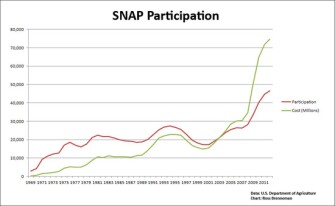The saga over food stamps continues.
The U.S. House of Representatives heard another day of arguments over a long-delayed farm bill this Thursday. Aside from farming, the bill also encompasses the Supplemental Nutrition Assistance Program (SNAP), formerly known as food stamps, which millions of children rely upon, and which eases some burden on schools to be primarily responsible for student nutrition.
The farm bill offers something for rural and urban constituents alike, meaning it usually doesn’t cause much controversy when it comes up for renewal. Yet the House failed to pass a farm bill last month, with conservative Republicans wanting deeper cuts to SNAP (among other areas of the bill) and Democrats wanting fewer cuts.
This led to a series of events that culminated this Thursday when, on a push from Agriculture Committee Chairman Frank Lucas (R-Okla.), the House decoupled SNAP from the farm bill, in order to pass what Lucas termed the “farm-bill farm bill,” or, the part of the farm bill that actually deals with farming. The measure passed, 216-208.
SNAP provides much-needed assistance to those in poverty, especially in a weak economy. Since the 2008 recession, SNAP participation increased at a much quicker rate:

This chart represents only benefit costs, which are currently around $74 billion total. With administrative costs, as well as employment and training program costs, etc., the total comes to a little under $78.5 billion. But as high as that number is, it only represents $133 per month, per person in benefits, or $4.43 daily over a 30-day period.
House Democrats tore into the Republican proposal.
“I want to make one thing clear: We are not going to vote for a bill that sticks it to poor people,” Rep. James P. McGovern (D-Mass.) said on the House floor yesterday. “There are 50 million people in this country who are hungry ... Please do not turn your backs on these people. We are a better country than that.”
McGovern’s citation of 50 million hungry people comes from the U.S. Department of Agriculture, and includes 16.7 million children. Schools usually fill the nutritional void, which is why the USDA has been pushing stringent rules for school meals, as obesity and poverty tend to go together.
And, as I wrote earlier this week, students have few places to turn for healthy food during summer, whether in rural, non-agrarian areas or in the food deserts found in many cities, where a McDonald’s value meal beats the cost of a pound of fruit.
Lucas promised that a separate nutrition bill would still be heard, but one that could focus on nutrition. Even if a nutrition bill didn’t pass Congress, the SNAP program is coded into law permanently, which means that it doesn’t just expire. But then it would need funding in the next appropriations bill, which hypothetically makes it an easier target for cuts.
This only matters if the bill became law, though, which the Democrat-controlled Senate will probably prevent, or which President Obama will veto.